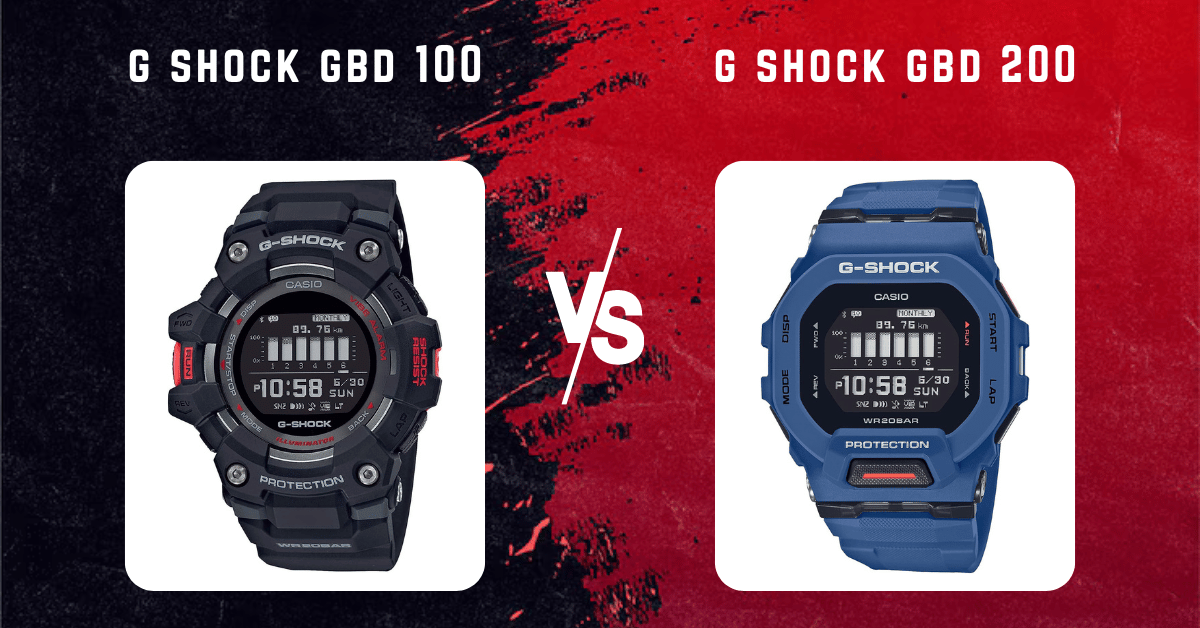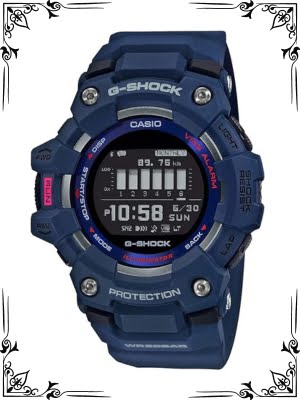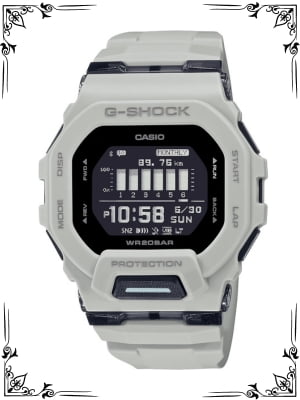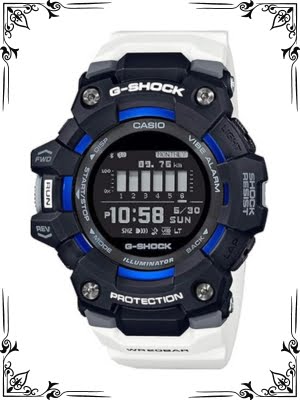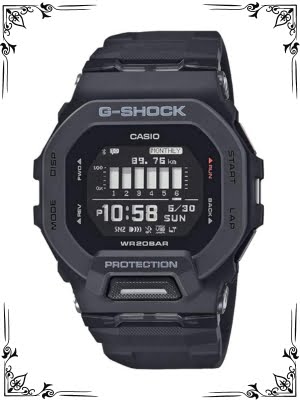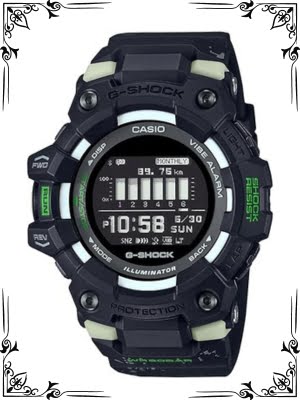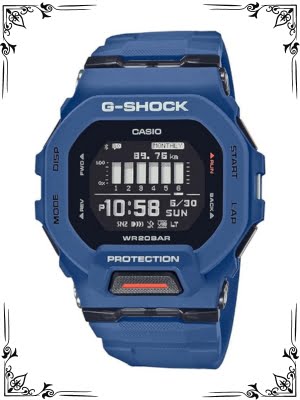The key difference lies in connectivity. The GBD-100 is a reliable fitness tracker with basic smartphone notifications. The GBD-200 ups the ante with Bluetooth connectivity, allowing for advanced app integration, automatic time syncing, and a wider range of smartphone notifications.
Introduction
The G-Shock GBD-100 and GBD-200 have taken the fitness watch world by storm. Both boast the legendary G-Shock toughness and functionality, seamlessly integrated with advanced fitness tracking features.
But with seemingly similar names, you might be wondering: what sets them apart? This detailed guide will equip you to choose the G-Shock that perfectly complements your fitness journey.
A Blast from the Past: A Look at G-Shock’s Legacy
Before diving into the specifics, let’s appreciate the heritage these watches share. G-Shock burst onto the scene in 1983 with the DW-5000C, a watch renowned for its near-indestructible construction.
Since then, G-Shock has become synonymous with toughness and functionality, catering to athletes, adventurers, and anyone who demands a watch that can keep up with an active lifestyle. The GBD-100 and GBD-200 continue this legacy, offering G-Shock durability with cutting-edge fitness tracking technology.
Technical Breakdown: Unveiling the Inner Workings
Now, let’s delve into the nitty-gritty of these G-Shock fitness trackers.
Movement:
Both the GBD-100 and GBD-200 utilize a reliable quartz movement powered by a standard battery (typically CR1220). Battery life is estimated to be around 3 years for the GBD-100 and 2 years for the GBD-200, depending on usage and Bluetooth connectivity features (GBD-200 only).
Materials and Construction:
Both watches live up to the G-Shock reputation for durability. Their cases are constructed from shock-resistant resin, and the mineral glass crystals offer excellent scratch resistance. Here’s a table outlining the size and weight differences:
| Feature | GBD-100 | GBD-200 |
|---|---|---|
| Case Size | 51.2 mm x 45.4 mm x 15 mm | 49.3 mm x 46.8 mm x 15 mm |
| Weight | 82 grams | 75 grams |
While the size difference is slight, the GBD-100 has a slightly bulkier profile due to its button layout. The GBD-200 offers a more streamlined feel.
Functions and Features:
Here’s a table outlining the key functionalities of each watch:
| Feature | GBD-100 | GBD-200 |
|---|---|---|
| Movement | Quartz (battery-powered) | Quartz (battery-powered) |
| Battery Life | Up to 3 years (CR1220 battery) | Up to 2 years (CR1220 battery) |
| Timekeeping | Digital and analog hands | Digital and analog hands |
| World Time | Yes | Yes |
| Stopwatch | Yes (up to 1/100th of a second) | Yes (up to 1/100th of a second) |
| Countdown Timer | Yes (up to 24 hours) | Yes (up to 24 hours) |
| Alarm | Yes (with snooze) | Yes (with snooze) |
| Illumination | LED backlight | LED backlight |
| Water Resistance | 200 meters (20 bar) | 200 meters (20 bar) |
| Bluetooth Connectivity | No | Yes |
| Mobile App Integration | No | Yes (via G-Shock Connected app) |
| Step Counter | Yes | Yes |
| Distance Tracking | Yes | Yes |
| Calories Burned | Yes | Yes |
| Speed and Pace | Yes (estimated) | Yes |
| Interval Training | Yes (5 sets) | Yes (5 sets) |
| Auto Lap | Yes | Yes |
| Manual Lap Memory | Up to 100 laps | Up to 100 laps |
| Training Log | Yes (with limited data) | Yes (detailed data via app) |
| Smartphone Notifications | Basic (call, email, SMS) | Wide range (calls, emails, texts, social media, etc.) |
Key Differences in Functionality:
As you can see from the table, the core fitness tracking functionalities – step counting, distance tracking, calorie burning, interval training, etc. – are present in both watches. However, the GBD-200 offers a more comprehensive experience due to Bluetooth connectivity and app integration:
Automatic Time Syncing: The GBD-200 automatically adjusts the time based on your phone’s signal, ensuring accuracy. The GBD-100 requires a manual time setting.
Advanced Training Data: The GBD-200 pairs with the G-Shock Connected app, allowing you to view detailed training data, set goals, and track progress over time. The GBD-100 offers a basic training log with limited data storage.
Wider Range of Smartphone Notifications: The GBD-200 displays notifications for calls, emails, texts, social media updates, and more. The GBD-100 only displays basic notifications for calls, emails, and SMS.
Design and Aesthetics: A Matter of Style
Both watches share the classic G-Shock design DNA with a focus on functionality. However, there are subtle aesthetic differences to consider:
Dial Design:
GBD-100: The GBD-100 features a bold and busy dial layout. The digital display and analog hands are clear and easy to read, but the additional sub-dials might feel cluttered for some users.
GBD-200: The GBD-200 maintains the core design elements but with a slightly cleaner and more streamlined dial. The sub-dials are integrated more subtly, offering a more contemporary look.
Case and Bracelet:
Both watches utilize a shock-resistant resin case. The GBD-100 has a slightly bulkier profile with a textured resin strap that emphasizes the rugged G-Shock aesthetic.
The GBD-200 features a more streamlined case and a softer, more pliable resin strap. This design choice offers a more comfortable and lightweight feel on the wrist.
Brand Image:
Both watches embody the core G-Shock values of toughness and functionality. However, the design language creates slightly different perceptions:
GBD-100: The GBD-100’s bolder design projects a sense of ruggedness and is ideal for those who prioritize a classic G-Shock look.
GBD-200: The GBD-200’s sleeker profile exudes a more modern and versatile aesthetic, making it suitable for both athletic activities and everyday wear.
User Feedback: What the Wearers Say
Here’s a glimpse into what fitness enthusiasts appreciate about each watch:
GBD-100:
- Users praise its affordability, durability, and easy-to-read display.
- The basic fitness tracking features are considered adequate for casual workouts.
- The comfortable fit and long battery life are frequently mentioned.
GBD-200:
- Owners love the convenience of Bluetooth connectivity and the detailed training data offered by the app.
- The wider range of smartphone notifications is appreciated for staying connected.
- The comfortable strap and lightweight design are often highlighted.
Common Problems: Potential Pitfalls to Consider
While both watches are renowned for their durability, a few minor issues have been reported:
GBD-100: The busier dial layout might be overwhelming for some users who prefer a cleaner aesthetic.
GBD-200: A small number of users have reported occasional Bluetooth connectivity hiccups, although these can often be resolved with app updates or phone reboots.
The Final Lap: Choosing Your Champion
Now that you’ve explored the technical specs, design nuances, and user experiences, it’s time to pick your G-Shock fitness champion. Consider these factors to make an informed decision:
Budget: The GBD-100 is the more affordable option.
Functionality: If you crave in-depth training data, automatic time syncing, and a wider range of smartphone notifications, the GBD-200 delivers a more comprehensive experience.
Style: Consider the dial layout and strap material. The GBD-100 offers a bold, classic G-Shock look, while the GBD-200 boasts a cleaner and more modern aesthetic.
Ultimately, the best G-Shock fitness watch is the one that perfectly complements your fitness goals and style preferences.
Conclusion
The GBD-100 and GBD-200 are both exceptional G-Shock options for fitness enthusiasts. The GBD-100 offers a reliable and affordable package with basic tracking features, while the GBD-200 takes it a step further with Bluetooth connectivity, app integration, and advanced functionalities.
By understanding their key differences and considering your individual needs, you can confidently choose the G-Shock that will be your reliable companion on your fitness journey.
FAQs
1. Are these watches waterproof?
Yes, both the GBD-100 and GBD-200 boast 200-meter water resistance, making them suitable for swimming, snorkeling, and other water activities.
2. Which watch is more accurate for tracking workouts?
The GBD-200 generally offers higher accuracy due to its access to GPS data (via your phone’s Bluetooth connection) for distance and pace tracking. The GBD-100 relies on estimated values for these metrics.
3. Can I replace the battery in these watches?
Yes, both the GBD-100 and GBD-200 use a standard CR1220 battery that can be replaced by a watchmaker or with some DIY know-how. However, the typical battery life of 3 years (GBD-100) and 2 years (GBD-200) means replacements shouldn’t be frequent.
4. Does the GBD-100 have any smartphone connectivity features?
The GBD-100 has very basic Bluetooth connectivity that allows for limited data transfer to the G-Shock Move app. However, it lacks the advanced features and app integration offered by the GBD-200.
5. Is there a G-Shock fitness watch with built-in GPS?
Currently, neither the GBD-100 nor GBD-200 have built-in GPS. However, some higher-end G-Shock fitness models, like the GBD-H1000, offer built-in GPS for more accurate distance and pace tracking without relying on a phone connection.

